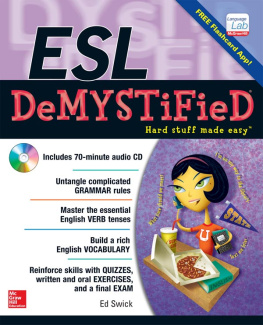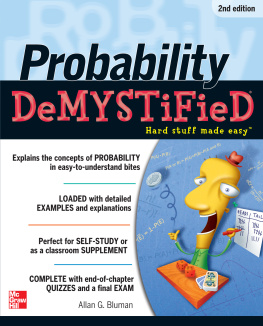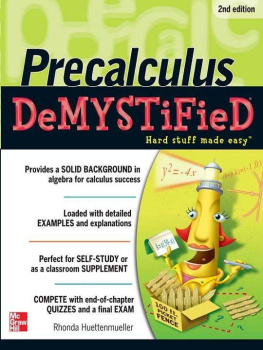DeMYSTiFieD Series
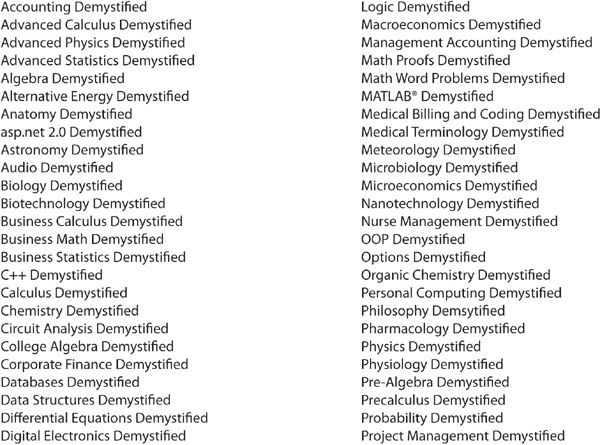
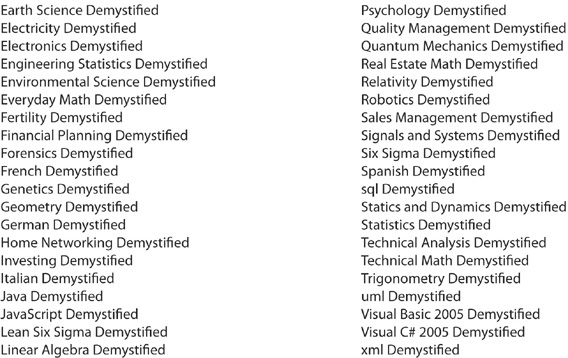


Copyright 2012 by The McGraw-Hill Companies, Inc. All rights reserved. Except as permitted under the United States Copyright Act of 1976, no part of this publication may be reproduced or distributed in any form or by any means, or stored in a database or retrieval system, without the prior written permission of the publisher.
ISBN: 978-0-07-175464-4
MHID: 0-07-175464-4
The material in this eBook also appears in the print version of this title: ISBN: 978-0-07-175463-7, MHID: 0-07-175463-6.
All trademarks are trademarks of their respective owners. Rather than put a trademark symbol after every occurrence of a trademarked name, we use names in an editorial fashion only, and to the benefit of the trademark owner, with no intention of infringement of the trademark. Where such designations appear in this book, they have been printed with initial caps.
McGraw-Hill eBooks are available at special quantity discounts to use as premiums and sales promotions, or for use in corporate training programs. To contact a representative please e-mail us at bulksales@mcgraw-hill.com.
Trademarks: McGraw-Hill, the McGraw-Hill Publishing logo, DeMystifi ed and related trade dress are trademarks or registered trademarks of The McGraw-Hill Companies and/or its affi liates in the United States and other countries and may not be used without written permission. All other trademarks are the property of their respective owners. The McGraw-Hill Companies is not associated with any product or vendor mentioned in this book.
TERMS OF USE
This is a copyrighted work and The McGraw-Hill Companies, Inc. (McGraw-Hill) and its licensors reserve all rights in and to the work. Use of this work is subject to these terms. Except as permitted under the Copyright Act of 1976 and the right to store and retrieve one copy of the work, you may not decompile, disassemble, reverse engineer, reproduce, modify, create derivative works based upon, transmit, distribute, disseminate, sell, publish or sublicense the work or any part of it without McGraw-Hills prior consent. You may use the work for your own noncommercial and personal use; any other use of the work is strictly prohibited. Your right to use the work may be terminated if you fail to comply with these terms.
THE WORK IS PROVIDED AS IS. McGRAW-HILL AND ITS LICENSORS MAKE NO GUARANTEES OR WARRANTIES AS TO THE ACCURACY, ADEQUACY OR COMPLETENESS OF OR RESULTS TO BE OBTAINED FROM USING THE WORK, INCLUDING ANY INFORMATION THAT CAN BE ACCESSED THROUGH THE WORK VIA HYPERLINK OR OTHERWISE, AND EXPRESSLY DISCLAIM ANY WARRANTY, EXPRESS OR IMPLIED, INCLUDING BUT NOT LIMITED TO IMPLIED WARRANTIES OF MERCHANTABILITY OR FITNESS FOR A PARTICULAR PURPOSE. McGraw-Hill and its licensors do not warrant or guarantee that the functions contained in the work will meet your requirements or that its operation will be uninterrupted or error free. Neither McGraw-Hill nor its licensors shall be liable to you or anyone else for any inaccuracy, error or omission, regardless of cause, in the work or for any damages resulting therefrom. McGraw-Hill has no responsibility for the content of any information accessed through the work. Under no circumstances shall McGraw-Hill and/or its licensors be liable for any indirect, incidental, special, punitive, consequential or similar damages that result from the use of or inability to use the work, even if any of them has been advised of the possibility of such damages. This limitation of liability shall apply to any claim or cause whatsoever whether such claim or cause arises in contract, tort or otherwise.
Contents
How to Use This Book
The important questions a historian asks are What happened? and Why did it happen? This book should help you to answer those questions on the topic of U.S. historythat is, from the arrival of the Indians on the North American continent up to the end of the Cold War in 1991.
History students are often confused by a wealth of information being thrown at them at oncenames, dates, presidents, and acts of Congress following one another in a bewildering array. The easiest way to sort out the confusion is to think about how events connect with one another. History is a long story of causes and effects. For example, the Missouri Compromise led indirectly to the Civil War. Provisions of the peace treaty signed at the end of World War I created the conditions that led to World War II. And so on. Its much easier to remember events when you understand how they relate to one another.
This book tells you the political, social, and cultural history of the United States in a narrative format, emphasizing the key ideas so you will understand why they are importantwhy congressional leaders compromised on slavery, what caused a major wave of migration or immigration, or why the Civil Rights movement began when it did. Each chapter deals with an important era or event in history, such as the Civil War or the Great Depression. Chapter topics can overlap in time, but the order of topics is basically chronological. The book is divided into three major sections:
begins with the first arrival of human beings in North America and ends shortly after the ratification of the U.S. Constitution.
covers the United States in the nineteenth century, including the Industrial Revolution, the Civil War, Reconstruction, and the Gilded Age.
narrates the course of U.S. history in the twentieth century, including both world wars, the Great Depression, and the Civil Rights movement.
Each chapter ends with a 10-question quiz, and each section ends with a 50-question exam. There is also a 100-question exam at the end of the book. The questions are all multiple-choice, similar to the sorts of questions used on standardized tests. Many of the questions ask you about causes and effects: Why did this event happen? What happened as a result of that decision?
You might try taking the chapter quiz first, before reading the chapter. This will tell you which sections of each chapter you already know well, and which sections you need to study further. Read and study the chapter, then take the quiz again. Keep working on each chapter until you can answer at least 9 of the 10 questions correctly.
Take each section exam after you have mastered the corresponding series of chapters, and take the final exam once you have mastered the entire book. Check your work against the answer key; if you answer at least 92 of the 100 questions correctly, you can consider that you have mastered the subject satisfactorily. Go back and study any areas of the book that cover questions you did not answer correctly.
If you are using this book as a course companion, follow along at the same pace your professor is taking. Use the book for extra tutorial and practice in addition to what is covered in class. If you are using the book as a substitute for taking a course, or to prepare yourself for an exam, then allow yourself time to get the most out of it. Allow three months, one month for each section of the book. Read the narrative, take the quizzes, and make a list of questions on aspects of U.S. history that arent clear to you. Use the sources recommended in the bibliography, or similar titles in the library or bookstore, to find the answers. When youre done with the course, you can use this book, with its comprehensive index, as a permanent reference.
Next page

